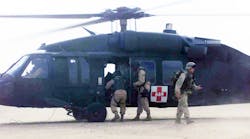Military troops are often faced with civilian evacuations which involve moving people of all ages and managing vehicles and communications systems of all types. The task is never simple, but researchers at a major university has stepped up with an innovative model that may help military troops expedite the evacuation of civilians during a disaster or when humanitarian relief efforts are needed.
The model, developed at sports powerhouse North Carolina State University in Research Triangle Park, N.C., was funded in part with support from the U.S. Army. It helps planners to plan the placement and timing of vehicles, troops and equipment during an evacuation to move civilians safely and effectively away from an area of danger. It also predicts requirements for food, water and shelter over extended periods of time to minimize stress on evacuees.
“What sets this tool apart from other models is that it is designed for use in both planning and during operations,” said Brandon McConnell, corresponding author of a paper on the new model and a research assistant professor in NC State’s Edward P. Fitts Department of Industrial and Systems Engineering. “In terms of specificity, we’re talking about where a given truck will be at any point in time during an operation.” Research on the novel evacuation model was published in the Journal of Defense Analytics and Logistics and was based on evacuation activities in South Korea, but could be applied to many different settings.
Research for the model was funded by means of a short-term innovation research grant from the Army covering nine-month study periods. Dr. Joseph Myers, mathematical sciences division chief at the Army Research Office, an element of U.S. Army Combat Capabilities Development Command’s Army Research Laboratory (ARL), explained: “The tool will need fine-tuning before it can be implemented—it would benefit from a user-friendly interface, for one thing—but it highlights the potential that operational models have for helping the military achieve its objectives both in or out of wartime.”
U.S. Army Captain John Kearby, first author of the paper and former NC State graduate student, noted: “There is a tremendous amount of complexity associated with the Army’s South Korea noncombatant evacuation mission, and that presents a great opportunity for investigation and improvement. The goal of this research was, and is, to encourage the development of better and more robust evacuation plans.”

